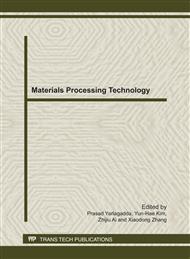p.466
p.470
p.474
p.479
p.489
p.494
p.498
p.503
p.507
Development of In-Process Chip Breaking Detection by Using Cutting Force and Temperature Signals
Abstract:
In order to realize the intelligent machines, an in-process monitoring system is developed to detect the continuous chip and the broken chip regardless of the cutting conditions on CNC turning by utilizing the power spectrum density, PSD of dynamic cutting force and the variance of the dynamic cutting temperature, which are measured during the cutting by employing the dynamometer and the infrared pyrometer. The broken chip formation is required for the reliable turning operation. The preliminary experiments suggested that there are basically two patterns of PSDs of chip forms. One is the case of relatively high PSD of the dynamic cutting force at low frequency range, which corresponds to the continuous chip formation. The other is the case of relatively large PSD of the dynamic cutting force observed in a frequency range corresponding to the chip breaking frequency when the broken chip are formed. The variances of the cutting temperature are also significantly different between the broken chip and the continuous chip. Hence, the method has been developed by using the PSD of dynamic cutting force and the variance of cutting temperature to determine the proper threshold values for classification of the broken chip and the continuous chip during the cutting. The new algorithm is proposed to obtain the broken chip by changing the cutting conditions during the cutting process. It has been proved by series of cutting experiments that the broken chip can be well identified by the proposed method even though the cutting conditions are changed.
Info:
Periodical:
Pages:
489-493
Citation:
Online since:
September 2011
Authors:
Price:
Сopyright:
© 2011 Trans Tech Publications Ltd. All Rights Reserved
Share:
Citation:


